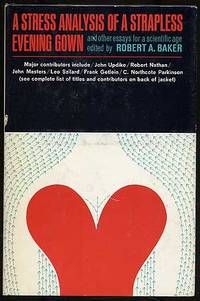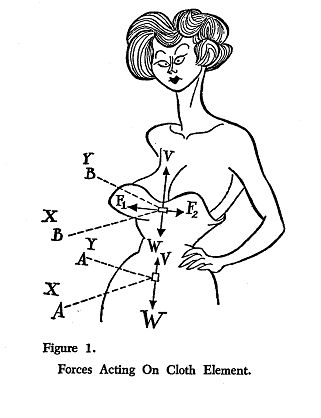 The following article is from The Annals of Improbable Research.
The following article is from The Annals of Improbable Research.
by Charles Seim
Berkeley, California
[Editor’s note: Charles Seim wrote this article in 1956. We are republishing it here with his permission. Seim went on to become one of the world’s most renowned bridge designers. On February 16, 2007, for the first time ever, he presented “Stress Analysis” as a public lecture. This was a featured part of the Improbable Research show at the American Association for the Advancement of Science’s Annual Meeting, held in San Francisco. Here is the full text of the original article.]
Since the beginning of recorded history, the human being has worn some sort of clothing either for protection or warmth. However, the present trend among the “fair sex” is to wear clothing not for protection or warmth, but solely to attract the attention of the opposite sex. To be more specific, it is through the use of clothing that the female most effectively catches the eye of the very appreciative but totally unsuspecting male.
A variety of methods are employed to bring about this libido-awakening infliction on the poor male. One very popular method employed by the female is to wear transparent or seemingly transparent cloth to good advantage in certain areas. A common example is the transparent nylon blouse. Another powerful attractant is the tightly fitted garment. A well-known example of the type of weapon is the sweater. Yet another provoking method is by actually reducing the extent of body surface covered by cloth. A good example of this method is the modern bathing suit (e.g., Bikini). A delightful device which has sufficiently aroused the masculine sex is the use of durable but fragile-appearing cloth which gives the impression that at any moment the garment will slip down or that, better yet, certain parts may slip out of place. The best example of this method of attracting the attention of the weak and susceptible male is the strapless evening gown.
Effective as the strapless evening gown is in attracting attention, it presents tremendous engineering problems to the structural engineer. He is faced with the problem of designing a dress which appears as if it will fall at any moment and yet actually stays up with some small factor of safety. Some of the
problems faced by the engineer readily appear from the following structural analysis of strapless evening gowns.
If a small elemental strip of cloth from a strapless evening gown is isolated as a free body in the area of plane A in Figure 1, it can be seen that the tangential force F1 is balanced by the equal and opposite tangential force F2. The downward vertical force W(weight of the dress) is balanced by the force V acting vertically upward due to the stress in the cloth above plane A. Since the algebraic summation of vertical and horizontal forces is zero and no moments are acting, the elemental strip is at equilibrium.
Consider now an elemental strip of cloth isolated as a free body in the area of plane B of figure 1. The two tangible forces F1 and F2 are equal and opposite as before, but the force W(weight of dress) is not balanced by an upward force V because there is no cloth above plane B to supply this force. Thus, the algebraic summation of horizontal forces is zero, but the sum of the vertical forces is not zero. Therefore, this elemental strip is not in equilibrium; but it is imperative, for social reason, that this elemental strip be in equilibrium. If the female is naturally blessed with sufficient pectoral development, she can supply this very vital force and maintain the elemental strip at equilibrium. If she is not, the engineer has to supply this force by artificial methods.
In some instances, the engineer has made use of friction to supply this force. The friction force is expressed by F = fN, where F is the frictional force, f is the coefficient of friction and N is the normal force acting perpendicular to F.
 Since, for a given female and a given dress, f is constant, then to increase F, the normal force N has to be increased. One obvious method of increasing the normal force is to make the diameter of the dress at c in figure 2 smaller than the diameter of the female at this point. This has, however, the disadvantage of causing the fibers along the line c to collapse, and if too much force is applied, the wearer will experience discomfort.
Since, for a given female and a given dress, f is constant, then to increase F, the normal force N has to be increased. One obvious method of increasing the normal force is to make the diameter of the dress at c in figure 2 smaller than the diameter of the female at this point. This has, however, the disadvantage of causing the fibers along the line c to collapse, and if too much force is applied, the wearer will experience discomfort.
As if the problem were not complex enough, some females require that the back of the gown be lowered to increase the exposure and correspondingly attract more attention.
In this case, the horizontal forces F1 and F2 (Figure 1) are no longer acting horizontally, but are acting downward at an angle shown (on one side only) by T. Therefore, there is a total downward force equal to the weight of the dress below B + the vector summation of T1 and T2. This vector sum increases in magnitude as the back is lowered because F = 2Ts in a, and the angle a increases as the back is lowered. Therefore, the vertical uplifting force which has to be supplied for equilibrium is increased for low-back gowns.
Since there is no cloth around the back of the wearer which would supply a force perpendicular to the vertical axis of the female that would keep the gown of the lady from falling forward, the engineer has to resort to bone and wire frameworks to supply the sufficient perpendicular forces. (Falling of dress forward, away from the wearer, is considered unfair tactics among females.)
If the actual force supplied is divided by the minimum force that is required to hold the dress up, the resulting quotient defines a factor of safety. This factor could be made as large as desired, but the engineers are required to keep the framework light and inconspicuous. Therefore, a compromise must be made between a heavy framework and a low factor of safety.
With ingenious use of these frameworks, the backs of strapless gowns may be lowered until cleavage is impending.
Assuming that the female is naturally endowed to supply the vertical force V, the problem is still left incomplete unless an analysis is made of the structures supplying this force. These structures are of the nature of cantilever beams. Figure 2 shows one of these cantilever beams (minus any aesthetical details) removed as a free body (and indeed, many such beams can be, in reality, removed as free bodies; e.g., certain artifacts). Since there are usually two such divided, the force acting on any one beam is F/2 and it is distributed over the beam from a. to c. Here exposure and correspondingly more attention can be had by moving the dress line from a. toward b. Unfortunately, there is a limit stress defined by S = F/2A (A being the area over which the stress acts). Since F/2 is constant, if the area A is decreased, the bearing stress must increase. The limit of exposure is reached when the area between b and c is reduced to a value of “danger point.”
The author presenting a lecture based on this study, in February 2007 at the American Association for the Advancement of Science’s annual meeting. Dr. Rebecca Slayton, right, helps demonstrate the basic concepts. Dr. Slayton has a Ph.D. in chemistry from Harvard University. She is a lecturer in the Science, Technology and Society Program at Stanford University. She is currently working on a book which uses the history of the U.S. ballistic missile defense pr ogram to study the relationships between and among technology, expertise, and the media.
A second condition exists which limits the amount of exposure. Vertical force F/2 is balanced by sheer force S acting on an area from d to e and by an internal moment M. The moment M causes tension in the fibers over the beams between e and a, and compression in the fibers between c and d. As the dress line is moved from A toward B, the moment M is increased, increasing the tension and compression again till “danger point.”
Since these evening gowns are worn to dances, an occasional horizontal force, shown in Figure 2 as i1, is accidentally delivered to the beam at the point c, causing impact loading, which compresses all the fibers of the beam. This compression tends to cancel the tension in the fibers between e and b, but it increases the compression between c and d. The critical area is at point d, as the fibers here are subject not only to compression due to moment and impact, but also to shear due to force S; a combination of low, heavy dress with impact loading may bring the fibers at point d to the “danger point.”
There are several reasons why the properties discussed in this paper have never been determined. For one, there is a scarcity of these beams for experimental investigation. Many females have been asked to volunteer for experiments along these lines in the interest of science, but unfortunately, no cooperation was encountered. There is also the difficulty of the investigator having the strength of mind to ascertain purely the scientific facts. Meanwhile, trial and error and shrewd guesses will have to be used by the engineer in the design of strapless evening gowns until thorough investigations can be made.  In 1992, singer/jazz-harpist Deborah Henson-Conant composed a five-movement musical version of “Stress Analysis of a Strapless Evening Gown,” based on Charles Seim’s engineering essay. The movements are:
In 1992, singer/jazz-harpist Deborah Henson-Conant composed a five-movement musical version of “Stress Analysis of a Strapless Evening Gown,” based on Charles Seim’s engineering essay. The movements are:
1. Introduction and waltz
2. Compression and tension
3. Gossamer
4. The Danger Zone
5. Curves
It premiered on Saturday night, November 21 of that year at the Regattabar Jazz Club in the Elliot Hotel in Harvard Square, Cambridge. Henson-Conant, wearing a strapless evening gown, performed it together with The Really Eclectic String Quartet. Subsequently, she performed the piece in jazz clubs around the world. On Saturday, February 10, 2001, Henson-Conant performed it together with the Springfield (Massachusetts) Symphony orchestra, and has since performed with other orchestras around the world. In 2006 Henson-Conant and the Grand Rapids Symphony released a DVD and CD titled “Invention & Alchemy,” which featured part of the “Stress Analysis of a Strapless Evening Dress.” The DVD was nominated for a Grammy Award in the category of “Best Classical Crossover Album."
_____________________
 The article above is republished with permission from the March-April 2007 issue of the Annals of Improbable Research. You can download or purchase back issues of the magazine, or subscribe to receive future issues. Or get a subscription for someone as a gift!
The article above is republished with permission from the March-April 2007 issue of the Annals of Improbable Research. You can download or purchase back issues of the magazine, or subscribe to receive future issues. Or get a subscription for someone as a gift!
Visit their website for more research that makes people LAUGH and then THINK.





